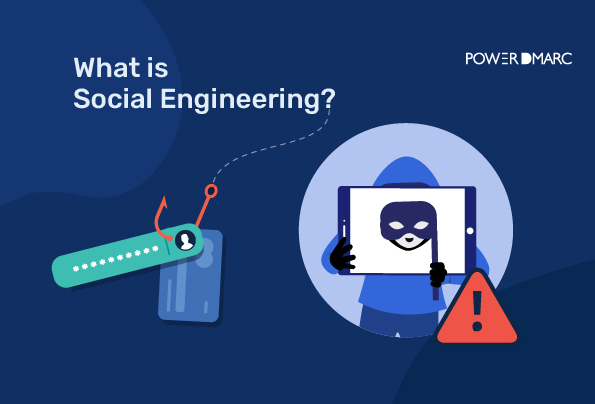Key Takeaways
- Social engineering uses psychological manipulation and exploits trust, rather than technical hacking, to deceive victims into revealing sensitive information or performing actions.
- Common attack vectors include phishing (email), vishing (voice calls), smishing (SMS), baiting (lures), and pretexting (creating false scenarios).
- Phishing is the most prevalent form, often involving emails disguised as legitimate communications to steal credentials or deliver malware.
- Be cautious of unsolicited requests for personal information, urgent demands, offers that seem too good to be true, and verify the identity of the requester through separate channels.
- Protect yourself through a combination of technical measures like multi-factor authentication and email authentication (DMARC, SPF, DKIM), and behavioral practices like user awareness training and strong password hygiene.
In cybersecurity, the greatest weakness is often not the technology but the people who use it. Attackers know this, which is why they increasingly rely on social engineering, a method of exploiting human trust rather than technical flaws. These attacks are subtle, persuasive, and often devastating, leading to financial loss and reputational damage that technology alone cannot prevent.
In this article, we’ll explore how social engineering works, the common tactics behind it, and the steps you can take to recognize and stop these attacks before they succeed.
What is Social Engineering?
Social engineering is the act of manipulating people into performing actions or divulging confidential information, often by exploiting psychological triggers like trust, curiosity, or helpfulness. It’s a form of hacking, but instead of technically breaking into computers, social engineers try to gain access to them by tricking employees into giving up information or downloading malware. A social engineer can make you an unwitting accomplice by using high-level manipulation to get whatever the attacker wants.
Protect Against Social Engineering with PowerDMARC!
Purpose of Social Engineering
Social engineering is often used in phishing email attacks, which are emails that appear to be from a trusted source but are actually aimed at stealing your personal information or deploying malware. The emails usually contain an attachment with malicious software (often called malware) or links to malicious websites that will infect your computer if opened or clicked.
The goal of social engineering is always the same: getting access to something valuable without having to work for it (from a technical hacking perspective).
Common objectives include:
- Stealing sensitive information – login details, client databases, or trade secrets.
- Committing identity theft – impersonating victims for fraudulent activities.
- Financial fraud – tricking employees into wiring money or approving payments.
- Gain unauthorized access – entering restricted areas, systems, or email accounts.
Common Types of Social Engineering Attacks
Social engineering isn’t limited to just one form of trickery. It manifests in various ways, depending on the attacker’s creativity and resources. Some attacks are highly technical, while others rely on a simple phone call or text message. The common thread is deception, but the tactics vary widely.
The following are the most frequent attack vectors organizations encounter:
- Phishing – Deceptive emails that mimic trusted sources to steal data.
- Spear phishing: Targeted attacks on specific individuals.
- Whaling attack: Targeting senior executives or decision-makers.
- Baiting – Offering something enticing (like free software or infected USB drives) to trick victims into installing malware.
- Pretexting – Creating a fabricated scenario to gain trust (e.g., pretending to be an auditor or IT support).
- Vishing (Voice Phishing) – Fraudulent calls convincing victims to reveal sensitive details.
- Smishing (SMS Phishing) – Fake text messages containing malicious links.
- Quid Pro Quo – Offering fake benefits (like free IT help) in exchange for credentials or access.
- Tailgating – Following authorized staff into secure premises.
Key Stages of a Social Engineering Attack
Social engineering attacks are rarely random. They unfold in a deliberate sequence, with each step designed to lower a target’s defenses gradually.
Understanding this progression means recognizing the warning signs early and responding before real damage is done.
Stage 1: Information gathering
The first stage is reconnaissance. Before reaching out, attackers invest time in collecting details about the organization and its people. This information can range from employee names and roles to vendor relationships and internal processes.
Sources are often public and easy to access: corporate websites, job postings, press releases, and social platforms such as LinkedIn provide attackers with a wealth of data. Even small details, like the formatting of email signatures or the technologies a company uses, can be enough to create a convincing ruse later.
Stage 2: Building trust
With background information in hand, attackers craft a credible pretext, a story or identity that will resonate with their target. At this stage, they position themselves as someone the victim is likely to trust: a manager, a colleague in another department, a service provider, or even a help desk technician.
The interaction is often polite, professional, and carefully worded to avoid suspicion. By aligning their story with the information gathered during reconnaissance, attackers increase the likelihood that the victim will accept the interaction as genuine.
Stage 3: Exploitation
This is the decisive moment when the attacker leverages the trust they have established. The request may seem routine or urgent, but it always serves the attacker’s end goal. Victims might be asked to click a link, download a file, provide login credentials, or authorize a financial transaction.
Because the groundwork of credibility has already been laid, the request feels natural, and that is precisely why it is effective. At this stage, hesitation is minimal, and many victims comply without realizing they are being manipulated.
Stage 4: Execution
Finally, the attacker achieves their objective. This could mean unauthorized access to a system, the theft of sensitive data, or the diversion of company funds. Skilled attackers often take additional steps to cover their tracks, erasing logs or withdrawing gradually to avoid detection. The longer they remain unnoticed, the more time they have to exploit their access and inflict lasting damage.
How to Recognize and Prevent Social Engineering
Social engineering works because it’s hard to spot in real time. Attackers disguise themselves as trusted contacts, create a sense of urgency, and exploit natural human tendencies.
That’s why the best defense starts with awareness and knowing the signs of an attack and how to respond effectively.
For Recognition
Employees should look out for these warning signs of a potential social engineering attempt:
- Unusual requests – especially if they involve money or sensitive data.
- Urgency or pressure – attackers want victims to act quickly without verifying.
- Suspicious sender details – email addresses or phone numbers that don’t match official records.
- Too-good-to-be-true offers – prizes, rewards, or free services.
- Requests for secrecy – attackers often insist the victim keep things confidential.
For Prevention
While recognition is the first step, prevention requires structured defenses. Organizations that combine employee training with technical safeguards are significantly more resilient against these attacks.
Best practices include:
- Training employees regularly on how to spot phishing and other scams.
- Implementing strong email security tools like DMARC, SPF, and DKIM in your email channels helps fight domain impersonation, phishing attacks, and other attacks.
- Verifying all requests for sensitive actions (payments, credentials) through a second channel.
- Using two-factor authentication whenever possible to protect accounts.
- Limiting access rights so employees only have the permissions necessary for their role.
- Conducting phishing simulations to test and reinforce employee vigilance.
Conclusion
Social engineering is one of the most dangerous threats in cybersecurity because it targets people rather than technology. By understanding what it is, the purposes behind it, the types of attacks, and the attacker lifecycle, organizations can better prepare their defenses.
Effective defense requires both human awareness and technical security controls. Proactive training, strong policies, and solutions like DMARC can protect your organization from costly breaches.
Frequently Asked Questions
What is the difference between social engineering and manipulation?
Social engineering is a form of manipulation with malicious intent, usually for financial gain or unauthorized access. Manipulation can exist in everyday interactions, but social engineering specifically exploits trust to execute cyberattacks.
What is an example of social engineering in the workplace?
A common example is an employee receiving an email that appears to be from their CEO requesting an urgent wire transfer. The attacker relies on the employee’s respect for authority and urgency to bypass normal security checks.

- Top 7 Best Email Verification Tools for Secure Delivery - November 28, 2025
- CNAME vs A Record: Which DNS Record Should You Use? - November 18, 2025
- DMARC MSP Case Study: How PowerDMARC Secures Amalfi Technology Consulting Client Domains from Spoofing - November 17, 2025



